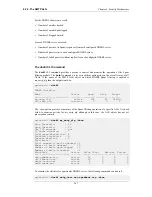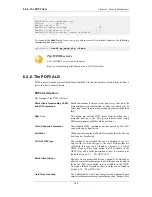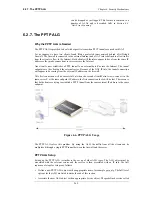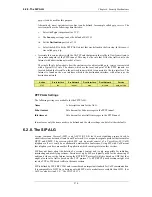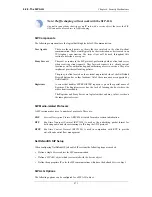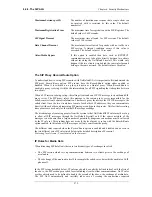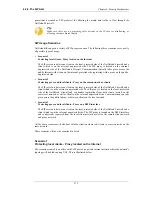
•
Destination Interface: wan
•
Source Network: lannet
•
Destination Network: all-nets
4.
Check Use Interface Address
5.
Click OK
Setting Up FTP Servers with Passive Mode
An important point about FTP server setup needs to be made if the FTP ALG is being used along
with passive mode.
Usually, the FTP server will be protected behind the NetDefend Firewall and NetDefendOS will
SAT-Allow connections to it from external clients that are connecting across the public Internet. If
FTP Passive mode is allowed and a client connects with this mode then the FTP server must return
an IP address and port to the client on which it can set up the data transfer connection.
This IP address is normally manually specified by the administrator in the FTP server software and
the natural choice is to specify the external IP address of the interface on the firewall that connects
to the Internet. This is, however, wrong if the FTP ALG is being used.
Instead, the local, internal IP address of the FTP server should be specified when setting up the FTP
server.
6.2.4. The TFTP ALG
Trivial File Transfer Protocol (TFTP) is a much simpler version of FTP with more limited
capabilities. Its purpose is to allow a client to upload files to or download files from a host system.
TFTP data transport is based on the UDP protocol and therefore it supplies its own transport and
session control protocols which are layered onto UDP.
TFTP is widely used in enterprise environments for updating software and backing up
configurations on network devices. TFTP is recognized as being an inherently insecure protocol and
its usage is often confined to internal networks. The NetDefendOS ALG provides an extra layer of
security to TFTP in being able to put restrictions on its use.
General TFTP Options
Allow/Disallow Read
The TFTP GET function can be disabled so that files cannot
be retrieved by a TFTP client. The default value is Allow.
Allow/Disallow Write
The TFTP PUT function can be disabled so that files cannot
be written by a TFTP client. The default value is Allow.
Remove Request Option
Specifies if options should be removed from request. The
default is False which means "do not remove".
Allow Unknown Options
If this option is not enabled then any option in a request other
than the blocksize, the timeout period and the file transfer size
is blocked. The setting is disabled by default.
6.2.4. The TFTP ALG
Chapter 6. Security Mechanisms
258
Содержание DFL-1600 - Security Appliance
Страница 27: ...1 3 NetDefendOS State Engine Packet Flow Chapter 1 NetDefendOS Overview 27 ...
Страница 79: ...2 7 3 Restore to Factory Defaults Chapter 2 Management and Maintenance 79 ...
Страница 146: ...3 9 DNS Chapter 3 Fundamentals 146 ...
Страница 227: ...4 7 5 Advanced Settings for Transparent Mode Chapter 4 Routing 227 ...
Страница 241: ...5 4 IP Pools Chapter 5 DHCP Services 241 ...
Страница 339: ...6 7 Blacklisting Hosts and Networks Chapter 6 Security Mechanisms 339 ...
Страница 360: ...7 4 7 SAT and FwdFast Rules Chapter 7 Address Translation 360 ...
Страница 382: ...8 3 Customizing HTML Pages Chapter 8 User Authentication 382 ...
Страница 386: ... The TLS ALG 9 1 5 The TLS Alternative for VPN Chapter 9 VPN 386 ...
Страница 439: ...Figure 9 3 PPTP Client Usage 9 5 4 PPTP L2TP Clients Chapter 9 VPN 439 ...
Страница 450: ...9 7 6 Specific Symptoms Chapter 9 VPN 450 ...
Страница 488: ...10 4 6 Setting Up SLB_SAT Rules Chapter 10 Traffic Management 488 ...
Страница 503: ...11 6 HA Advanced Settings Chapter 11 High Availability 503 ...
Страница 510: ...12 3 5 Limitations Chapter 12 ZoneDefense 510 ...
Страница 533: ...13 9 Miscellaneous Settings Chapter 13 Advanced Settings 533 ...
























